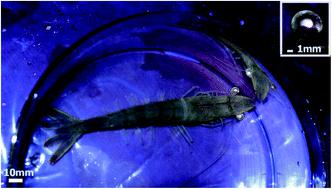当前位置:
X-MOL 学术
›
Faraday Discuss.
›
论文详情
Our official English website, www.x-mol.net, welcomes your
feedback! (Note: you will need to create a separate account there.)
Characterization and possible function of an enigmatic reflector in the eye of the shrimp Litopenaeus vannamei.
Faraday Discussions ( IF 3.3 ) Pub Date : 2020-05-16 , DOI: 10.1039/d0fd00044b Nathan Schiffmann 1 , Eyal Merary Wormser 2 , Vlad Brumfeld 3 , Yoseph Addadi 4 , Iddo Pinkas 3 , Venkata Jayasurya Yallapragada 5 , Eliahu D Aflalo 6 , Amir Sagi 7 , Benjamin A Palmer 1 , Steve Weiner 1 , Lia Addadi 1
Faraday Discussions ( IF 3.3 ) Pub Date : 2020-05-16 , DOI: 10.1039/d0fd00044b Nathan Schiffmann 1 , Eyal Merary Wormser 2 , Vlad Brumfeld 3 , Yoseph Addadi 4 , Iddo Pinkas 3 , Venkata Jayasurya Yallapragada 5 , Eliahu D Aflalo 6 , Amir Sagi 7 , Benjamin A Palmer 1 , Steve Weiner 1 , Lia Addadi 1
Affiliation

|
Reflective assemblies of high refractive index organic crystals are used to produce striking optical phenomena in organisms based on light reflection and scattering. In aquatic animals, organic crystal-based reflectors are used both for image-formation and to increase photon capture. Here we report the characterization of a poorly-documented reflector in the eye of the shrimp L. vannamei lying 150 μm below the retina, which we term the proximal reflective layer (PR-layer). The PR-layer is made from a dense but disordered array of polycrystalline isoxanthopterin nanoparticles, similar to those recently reported in the tapetum of the same animal. Each spherical nanoparticle is composed of numerous isoxanthopterin single crystal plates arranged in concentric lamellae around an aqueous core. The highly reflective plate faces of the crystals are all aligned tangentially to the particle surface with the optical axes projecting radially outwards, forming a birefringent spherulite which efficiently scatters light. The nanoparticle assemblies form a broadband reflective sheath around the screening pigments of the eye, resulting in pronounced eye-shine when the animal is viewed from a dorsal-posterior direction, rendering the eye pigments inconspicuous. We assess possible functions of the PR-layer and conclude that it likely functions as a camouflage device to conceal the dark eye pigments in an otherwise largely transparent animal.
中文翻译:

南美白对虾眼中神秘反射器的表征和可能的功能。
高折射率有机晶体的反射组件用于基于光反射和散射在生物体中产生引人注目的光学现象。在水生动物中,基于有机晶体的反射器用于图像形成和增加光子捕获。在这里,我们报告了南美白对虾眼中记录不足的反射体的特征位于视网膜下方 150 μm,我们称之为近端反射层(PR 层)。PR 层由密集但无序的多晶异黄蝶呤纳米颗粒阵列制成,类似于最近在同一动物绒毡层中报道的那些。每个球形纳米颗粒由许多异黄蝶呤单晶板组成,这些单晶板以同心薄片状排列在水核周围。晶体的高反射板面均与颗粒表面相切排列,光轴径向向外突出,形成双折射球晶,可有效散射光。纳米粒子组件在眼睛的屏蔽色素周围形成宽带反射鞘,当从背背方向观察动物时,会产生明显的眼睛光泽,使眼部色素不显眼。我们评估了 PR 层的可能功能,并得出结论,它可能作为一种伪装装置来隐藏原本大部分透明的动物的黑眼圈色素。
更新日期:2020-05-16
中文翻译:

南美白对虾眼中神秘反射器的表征和可能的功能。
高折射率有机晶体的反射组件用于基于光反射和散射在生物体中产生引人注目的光学现象。在水生动物中,基于有机晶体的反射器用于图像形成和增加光子捕获。在这里,我们报告了南美白对虾眼中记录不足的反射体的特征位于视网膜下方 150 μm,我们称之为近端反射层(PR 层)。PR 层由密集但无序的多晶异黄蝶呤纳米颗粒阵列制成,类似于最近在同一动物绒毡层中报道的那些。每个球形纳米颗粒由许多异黄蝶呤单晶板组成,这些单晶板以同心薄片状排列在水核周围。晶体的高反射板面均与颗粒表面相切排列,光轴径向向外突出,形成双折射球晶,可有效散射光。纳米粒子组件在眼睛的屏蔽色素周围形成宽带反射鞘,当从背背方向观察动物时,会产生明显的眼睛光泽,使眼部色素不显眼。我们评估了 PR 层的可能功能,并得出结论,它可能作为一种伪装装置来隐藏原本大部分透明的动物的黑眼圈色素。











































 京公网安备 11010802027423号
京公网安备 11010802027423号